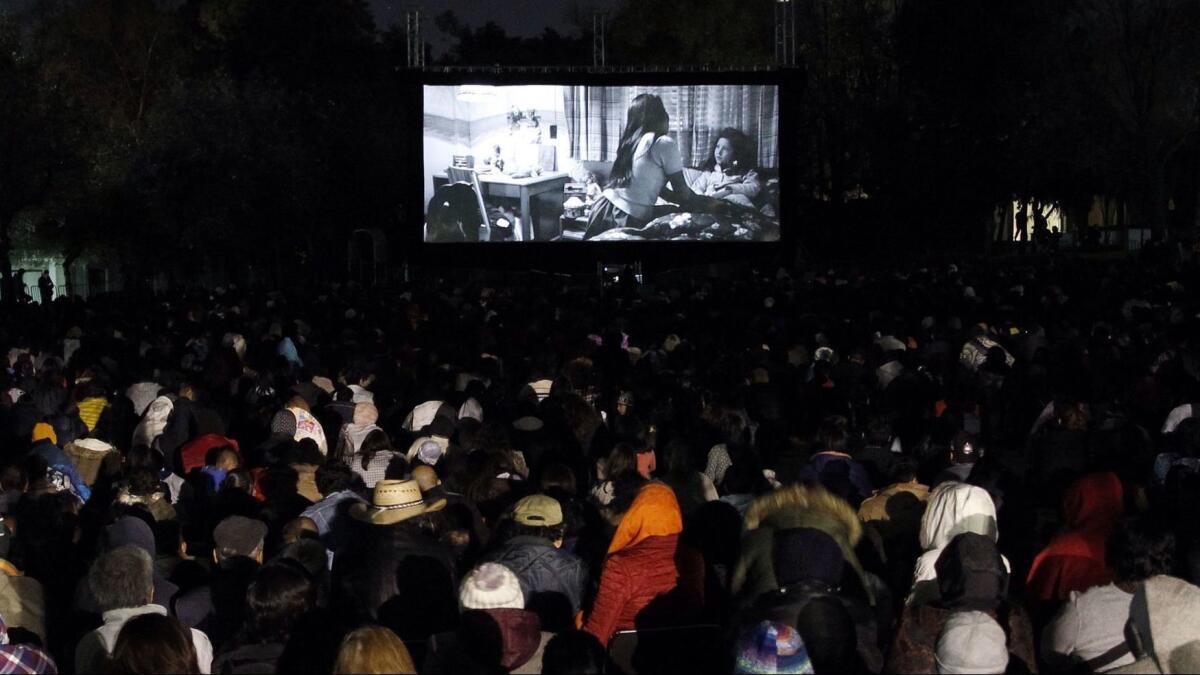Op-Ed: Let “Roma” start a conversation about the household workers we employ

Alfonso Cuarón’s “Roma” is being touted as a masterpiece for the way it tells an epic story through a granular examination of the everyday life of a middle-class family in early 1970s Mexico City. By focusing on the lives of the “help,” Cleo and Adela (Yalitza Aparicio and Nancy García), Cuarón has inverted the typical picture of Mexican domestic life by foregrounding the indigenous women who are visible, if at all, usually only at the edges of the frame.
The film opened in Mexico last month, just days before the inauguration of President Andrés Manuel López Obrador (known popularly by his acronym, AMLO), the first proper leftist to take power in Latin America’s second most-populous country in several generations. AMLO cut his teeth in politics by organizing among the indigenous populations of southern Mexico and his new administration has pledged more investment in social programs and regional development to aid indigenous Mexicans. By example, he also hopes to help change the discriminatory attitudes toward Indians of Mexico’s mestizo population, with its mix of European and indigenous ancestry.
It is, in other words, a moment of reckoning in Mexico, and the film has helped to focus the conversation on the legacy of colonialism and how it extends to the most intimate of spheres – as inside Cuarón’s autobiographical home in “Roma,” where Cleo and Adela, Mixtec Indians from Oaxaca, work from dawn until well into the night picking up after four young children, cracking soft-boiled eggs at the dinner table and sweeping up dog poop (a task forgotten often enough to suggest silent rebellion).
“Roma” takes its name from the Mexico City neighborhood that Cuarón grew up in, but it could just as well be set in contemporary Silver Lake or Sherman Oaks.
The conversation taking place in Mexico around household employment is one that should also be taking place in L.A., and other cities across the United States where an army of domestic workers tends to the needs of middle and upper middle class families. Yet there’s little sign of that, despite the ebullient Oscar buzz the film is generating. The film takes its name from the eponymous Mexico City neighborhood that Cuarón grew up in, but it could just as well be set in contemporary Silver Lake or Sherman Oaks.
By the end of the 1990s, at the peak of a great wave of migration, Latin American women had largely replaced African American women as domestics in California. A great many of these women are indigenous. Like Cleo and Adela, they coo to the children they care for in English and Spanish (and Zapotec, Otomí and dozens of other indigenous languages). These relations often transcend language. In “Roma,” there is also a lot of touching between the domestics and their charges -- playful, tender, and on occasion gently disciplinary.
It is a troubled intimacy, one haunted by colonial ghosts.
When my twin daughters were born 11 years ago, their mother and I employed several women part-time to help us as we hopscotched across Los Angeles to and from our jobs. The woman who stayed on the longest, was from Oaxaca. Her name, like that of one of the indigenous characters in Roma, is Adela, and she has lived in this country for more than 29 years without returning to her village for fear that she’d never be able to make it back across a border that became ever more militarized. She made the calculation that millions of others in her situation have made: If she were trapped on the other side, what then would become of her four daughters born and raised in the United States? Today, two of them are college graduates and one is still in school. But staying here led to an inevitable price for Adela. Last year, her mother died back home. They had not seen each other, had not kissed or embraced, in decades. Their goodbyes were over a cellphone.
On occasion I’d be home when Adela was working and it was nap time for the twins. Walking by the bedroom I’d hear her whispering to them in Spanish and Zapotec, and see her fingers spidering lightly over my girls’ heads. The twins, now tweens, still cherish the memory of those moments. There was something so familiar, so soothing in that gentle tapping across their scalps that would guide them to peaceful sleep.
Enter the Fray: First takes on the news of the minute from L.A. Times Opinion »
I can only think of that touch in Spanish, as a caricia, a caress, one that is exchanged only among closest family. I know that Adela is and is not part of my family, that her caricias perhaps came at the expense of spending time with her own children, and that we could never truly repay her for that loving touch — certainly not with a salary that would allow her to find the same kind of care for her children. Class and culture and to an extent language – colonial history – separate us. In this asymmetrical relationship, I get the sense that Adela knows my family far better than we will ever know her.
That I am a mestizo man who can converse relatively intimately with Adela complicates the story – but perhaps not by much. This relationship, in all its messiness, establishes me as a subject of colonial history just as much as Adela is. In “Roma,” Cuarón provokes with a question that the indigenous subject seems to be addressing to the Mexican middle class: Who are you, in relation to us?
It is a question that we need to ask ourselves on this side of the border as well. Forget Trump’s wall for the moment: What of the social and economic walls putative progressives have built between themselves and the immigrant working class?
The question posed in “Roma” is this: Who are we in relationship to one another, in a world made and undone by the curse of modernity – by material wealth and its ever more radically uneven distribution?
The Cleos and Adelas among us are waiting for our answer.
Ruben Martinez is a professor at Loyola Marymount University and author of “Crossing Over: A Mexican Family on the Migrant Trail.”
More to Read
A cure for the common opinion
Get thought-provoking perspectives with our weekly newsletter.
You may occasionally receive promotional content from the Los Angeles Times.










